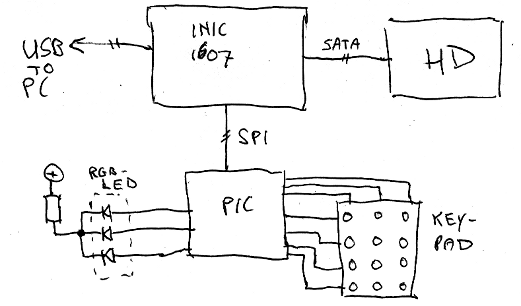More unpacking
Looking into the hardware means I had to open the device and see what's inside.
To open the enclosure, it suffices to unscrew two hidden
security-torcs-screws. While theoretically this would mean not too much people
have the means to unscrew these, in practice you can get the corresponding bits fairly
easily. Mine came from a set I purchased for ten euros or so.
And with the enclosure opened, this is what we get. The device consists of the PCB
with the electronics and keyboard on it, plus a bog-standard 250G SATA-drive, in my
case a WD Scorpio Blue laptop-drive.
The electronics. The device consists of 3 chips. From left to right, there's the chip with yellow paint on it.
Next to it is a square one which seems to be
an Initio INIC-1607E-chip. The chip itself is
quite undocumented: it doesn't even show up at Initios website. The third chip is a
25F010 which is a small EEPROM which presumably stores the firmware for the
Initio-chip.
I'm still not too sure if they put the paint on the first chip to obscure its makings
or for another reason. If it's for obfuscation, it's not a good protection measure:
a bit of scrubbing with a nice strong solvent (I used turpentine) will uncover the
typenumber: The chip is a fairly standard PIC16F883 8-bit general purpose
microcontroller. A bit of tracing and measuring also resolves the significance of the
unpopulated header next to it: it's the interface that could be used to connect
a low-voltage PIC-programmer to in order to reprogram or debug the chip.
After some measuring and prodding the hardware, it seems like it's designed like this:

The INIC-chip sits between the USB-port and the SATA-HD. According to various specs
on the Internet, it can do AES256-encryption on the fly. That, combined with the fact
that the pic would be too slow to do it, indicates that the INIC is responsible for
moving and en/decrypting the data on the hard disk. The PIC controls both the RGB-led
and the keypad, and communicates with the INIC over a serial bus.